In 2008, Dodge needed both a midsize SUV and a replacement for the short-wheelbase Caravan minivan. With the engineering staff decimated by years of Daimler control, they turned to the newly created Dodge Avenger sedan (JS body), whose core dimensions had come from the Mitsubishi GS (Galant) platform; using the Avenger for dimensions, powertrains, assemblies, and styling cues, the team created the Dodge Journey.
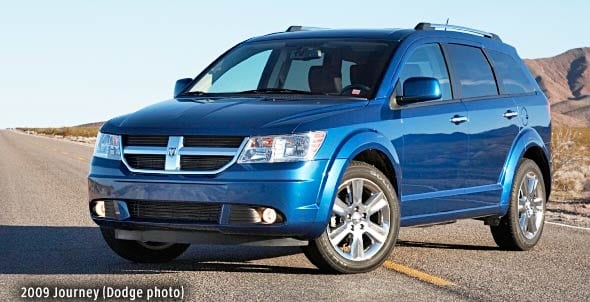
First shown at the 2007 Frankfurt Motor Show, the Dodge Journey’s JC body was taller and longer than the Avenger; its wheelbase matched the short-wheelbase 2007 minivans, which it was meant to replace. Chrysler had enjoyed great success for many years with short and long minivans, but with endemic cost-cutting, they only had the budget for longer minivans (they also claimed short-wheelbase minis were barely profitable).
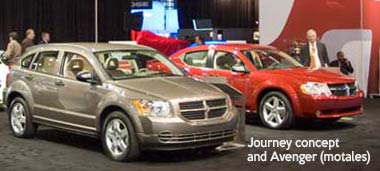
The Journey had one advantage over the outgoing Dodge Caravan: it lacked “minivan stigma,” the odd but growing feeling among buyers that minivans were for people older/more sensible/less fun than they were. For responsible parents, the Journey did have a driver’s spy mirror aimed at the back seat and a built-in child booster seat; and for those wanting to distract kids, an expensive optional rear seat audio system was mounted in the roof, where it couldn’t be reached by kids’ hands. (That pod also had vents to keep back-seat passengers happy.)

The Journey was regarded as good-looking, if not groundbreaking, on the outside; its normal two rows, with an optional third row, hit the heart of the people-mover market. Powertrains were shared with the Avener sedan—a 2.4 liter four-cylinder paired to a four-speed automatic, or a 3.5L V6 paired to a six-speed automatic (which was somewhat ironic because the 2.4 needed the wider range of the six-speed more than the 3.5 did). The Journey’s heavy weight made the four-cylinder seem quite underpowered to many people; the driving dynamics of these first years were not impressive, with prominent body roll, though this was not unheard of in this segment.
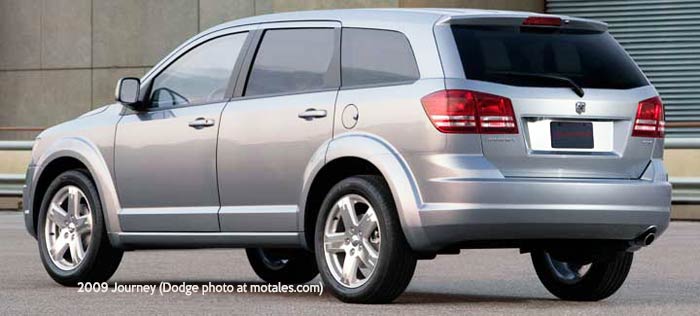
Three primary trim levels were available at first: SE, SXT, and R/T. The SE was not meant to have that may sales, but kept the base price low with its 16” steel wheels; but it did have air conditioning and a six-speaker sound system. It was only sold with four wheel drive, the 173-hp (166 lb-ft) four-cylinder, and front wheel drive (FWD).
Buyers wanting the third row or all wheel drive options had to move up to the SXT. The SXT had other advantages—alloy wheels, automatic headlights, keyless entry, more interior storage compartments, satellite radio, power seat, “stain resistant” cloth seat material, heated side mirrors, and the 235-hp 3.5L V6, which made 232 lb-ft of torque. The V6 was paired to the six-speed automatic transmission.

It’s worth taking a moment to talk about the two engines. The 2.4 four-cylinder was a sturdy design, in hindsight, but it required a great deal of revving to get its peak power levels and felt weaker than it was; its loud sewing-machine drone didn't help. The V6 had almost immediately made many friends, but the tight engine bay meant that the Journey got much less power out of it than the 300M had and the 300 still did—losing 15 hp and 18 lb-ft.
The Journey R/T used larger alloy wheels with lower-profile tires and a stiffer suspension to justify the R/T name; it also had roof rails, two-zone climate control, heated leather seats, remote start, and a leather-wrapped steering wheel. It too was V6-only and FWD with an AWD option.
David Zatz drove the 2009 Dodge Journey R/T for Allpar.com, concluding that the interior did not look quite as bad as critics made it out to be, though the gauges were quite small and the chunky door panels were not pleasing. The center stack in the well-equipped test car had handy features such as the hard-drive-carrying MyGiG stereo/DVD player. He did criticize the system for requiring too much attention while driving, though he found the backup camera helpful: MyGIG had a single tiny knob and was set too low in the dash. The ceiling mounted rear seat video came in for some praise, as did both front and rear climate control and a child-monitor mirror. He thought the “ChillZone” air-conditioned glove compartment was a gimmick.

Some criticized the “chunky look” interior styling which brought “SUV flavor” to a standard car-based crossover. This theme was used on several Chrysler vehicles (starting with the Dodge Caliber), and the Journey was the last to have it. More seriously, the thick rear pillars seriously obstructed vision.

The rear underseat storage was one of the Journey’s better features, using a watertight liner which could be purchased at any dealer. In theory, one could have five or six, loaded with toys, fishing gear, etc., and drag each one into the car. The interior as a whole had less space than expected, but at least it was relatively easy to get into the third row seats; it helped that there were foot spaces underneath the front and middle row seats. Rear doors opened by 90° to help access.

Dr. Zatz found the gas mileage to be an issue, with EPA ratings of just 15 city, 22 highway with the 3.5 liter V6, all wheel drive, and automatic; the four-cylinder with front wheel drive was rated 19/25. The four-cylinder did 0-60 mph in a leisurely 9.6 seconds but did not react well to added weight. V6 acceleration was better, running to 60 in 8 seconds flat; it seemed smooth and well-programmed. The base price of the SXT V6 was $23,300, while the R/T AWD was $28,295; the test car was a high $34,240, with rear seat video, sunroof, and rear seat climate control all being big-ticket items. The 2010 Journey was similar but added active front head restraints, an upgraded entertainment system, and standard keyless entry.
The Journey was something of a flop at first, or so it would seem in retrospect, with just 47,097 sales in 2008; 53,826 in 2009; and 48,577 sales in 2010. It was in a competitive segment, rapidly becoming the heart of non-pickup car sales in the US. However, Chrysler changed hands twice in 2007-09, with the second switch part of a very public bankruptcy, and people were generally not all that confident in the company. The Avenger’s sales were even worse in 2009, and quite close to the Journey’s in 2010. (All sales figures here are US sales. The Journey had a higher market share in Canada and minimal sales in Mexico.)
To solve the sales problem of a crossover that should have been selling in the six figures, Chrysler made many changes in mid-2010 for the 2011 Dodge Journey.

The 2011 Journey was refreshed with LED tail lamps, new wheels, a redesigned interior, and styling tweaks to the front fascia and grille. The interior used better materials than the hard, brittle plastics in the outgoing model. The suspension, powertrain, and steering were retuned to feel more responsive. The telematics were completely replaced, using third-generation Uconnect systems and an optional 8.4” system like that of the 2011 Charger and 300C. The instrument cluster screen was also new and had more standard features, including push-button start and Keyless Enter ’n’ Go.

The V6 engine was replaced with a 283-horsepower 3.6L Pentastar V6 engine (adding nearly 50 hp), but the transmissions stayed the same. The Pentastar had a bit less torque right off the line but quickly made up for it. Extra sound deadening material made the cabin a quieter place to spend time, and helped counter the 2.4’s sewing-machine buzzing.

All this work came as part of a complete upgrade of Chrysler interiors. In 2007, DaimlerChrysler ruled; in 2008, Cerberus ran the company; and in 2009, Fiat took charge. Both Cerberus and Fiat upgraded the interiors, so that the Journey created in 2008 had a massive injection of cash into the interiors budget. It helped that someone noticed that the bulgy, blocky, and rough styling of the chunky look was not helping.

The trim levels for 2011 expanded to five models: Express, Mainstreet, Crew, R/T, and Lux. The new trims were launched with great fanfare, as they were said to be tailored to specific buyer profiles, but most died with a whisper over time.

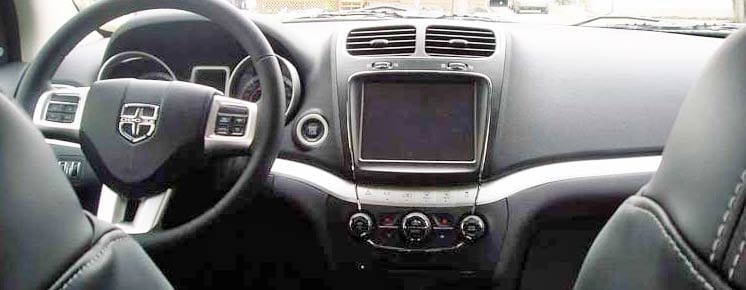
The 2011 model’s driving dynamics improved significantly, thanks to the retuned suspension and steering. Handling was improved without sacrificing ride quality, and the steering was much more direct than the previous model.

Sales should have shot up, but remained stubbornly low in 2011, with 55,155 Journeys changing hands.
Once again, the trim lineup was changed; for 2012, the Journey’s trim lineup consisted of American Value Package, SE, SXT, R/T, and Crew.
The discounting and other changes seem to have worked well, with U.S. sales jumping up to 79,563.
For 2013, new content included 17” wheels standard on AVP, SE, and SXT wheels. SXT was now available with the 8.4” Uconnect system and a sunroof. The Crew price was lowered by $200; the deal was made more attractive by standard leather seats, heated steering wheel, and heated front seats.

The Journey R/T saw a price reduction of $1,000 and got new perforated-leather seats (for comfort on hot days), a dimpled, leather-wrapped heated steering wheel with red stitching, and an updated performance suspension.
Two general additions were a “Max” air conditioning setting and an instant fuel economy readout on the EVIC screen.
The 2013 Journey was also available with a new Blacktop package, optional on the SXT. It could be paired with either the 4-cylinder or V6 and added 19” black wheels, a black grille, black headlamp bezels, black mirrors, and black trim on the front fascia. It had either black cloth seats or heated black leather seats. Again sales rose, to 83,933 for the year; the Journey was taking off—but not catching up to the Avenger, whose sales were higher than the Journey in 2010-2013.
For 2014, the Crew trim level was renamed Limited; the SXT gained more options (navigation, entertainment system, heated leather seats). All 2014s had SiriusXM satellite radio built in. A new Journey Crossroad model used the four-cylinder (V6 optional) with a more rugged looking front fascia, silver faux skid plate, black grille, light bezels (front and rear), bright roof rails, and black 19 inch wheels. The Crossroad also had black leather seats with mesh inserts, light gray stitching, and a new “Liquid Graphite” finish on various trim pieces. Options included the 8.4” Uconnect system, power driver’s seat, and flat-folding front passenger seat.
For 2014, buyers of the cheap SE could get all wheel drive in a package with the V6. TravelLink and satellite traffic were added to all 2015 Journeys with Uconnect 8.4. With the 2016 Journey; AVP was dropped, the SE’s price fell by $2,600, and Crossroad Plus replaced the Limited, so the Crossroad itself switched to cloth seats and the smaller center screen. Every Journey but the R/T now had the four-cylinder front-drive system standard, with V6 optional and AWD optional for V6 buyers.
Despite doomsayers claiming nobody would want the four-cylinder, sales boomed in these years, hitting their peaks—
One would think the Journey was due for a new generation—but since Jeep could command higher prices, the Journey’s place was given to the new Jeep Cherokee instead. Launched as a 2014, the Cherokee had a nine-speed automatic and garnered more attention than the Journey, at least at first.
While the Cherokee was likely meant to bury the Journey, not to join it, it was hard to argue with six-figure sales, and Dodge didn’t argue. Instead they invested some more into upgrades, though not a new generation of the aging Dodge.

David Zatz reviewed the upgraded 2017 Dodge Journey for Allpar; he was satisfied with the many changes, including a much more refined appearance on the Crossroad Plus. It had started with a four-inch screen in 2009; the test car had Chrysler's big 8.4 inch system, now raised well above the climate control and sharing two of the climate system’s big knobs. The gauge cluster was small, but now had a graphical trip computer/turn-by-turn navigator. A USB port provided better iPod/iPhone access than the original aux input had, and the car also came with SD input; either USB or SD card could provide music.

Dr. Zatz found the 283-hp Pentastar engine to be predictable and calm, with good launches every time and smooth shifting afterwards. The ride and handling were both good even on broken or wet concrete. Seats were more comfortable and far better looking; and the interior had numerous “surprise and delight” features. Gas mileage had gone up to 16 city, 24 highway with the new engine. The old four-cylinder provided the same mileage it had before.
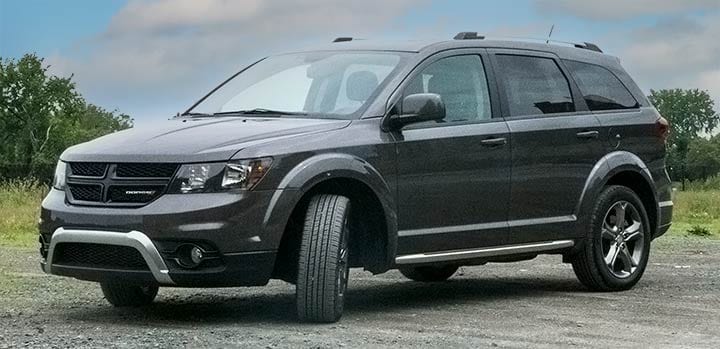
Sales paradoxically fell to 89,470 in 2017, and Dodge simplified the lineup, dropping Crossroad Plus and replacing R/T with GT. Third row seats were now standard even on SE; Crossroad models got updated 19” wheels in “Satin Carbon” or “Black Noise.” A Blacktop package was available on SE, SXT, and GT, adding black exterior accents. Sales rose to 94,096.

The 2019 Journey did without the SXT, but the SE was upgraded with fog lamps, three-zone climate control, and LED tail lights, as well as “performance fascias.” The 2020 Journey arrived without the GT, coming in SE Value and Crossroad levels only, and without the V6 or all wheel drive. Buyers saw only front drive, four cylinder models. The Crossroad gained a sunroof. This was its last year after nearly a decade of only minor updates: the Journey would be unable to meet future safety regulations if left in production, and its factory space in Toluca, Mexico was needed for the Jeep Compass. With the writing on the wall, sales dropped to 74,686 in 2019, then down to 40,342 in 2020, and finally the 14,035 leftovers found new homes in 2021. More Journeys would pop up from time to time for years to come.

The Journey was not especially successful at first, but it did find many happy buyers; bargain pricing helped with sales, and it was a reasonably well-made, comfortable car. The loss of the Journey had more to do with “not invented here,” brand priorities, and investment choices than sales, in the end. The Fiat Freemont version did fairly well on foreign shores; in some countries it was sold alongside the Dodge Journey, differentiated by trim and appearance.

See how Jeep, Dodge, Ram, Chrysler do on new quality-vs-cost chart
Italy slaps Elkanns’ wrists in tax case
Copyright © 2021-2025 Zatz LLC • Chrysler / Mopar car stories and history.
YouTube • Editorial Guidelines • Videos
Tailfins Archive • MoTales on BlueSky